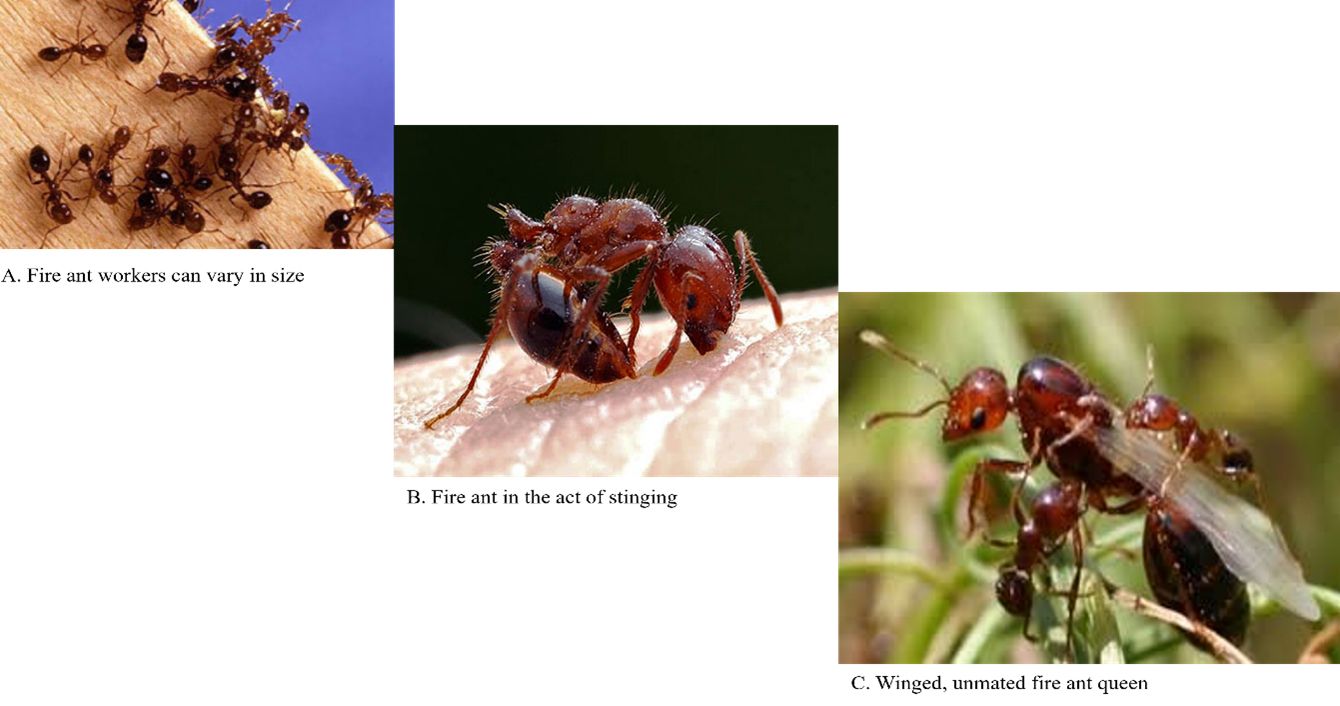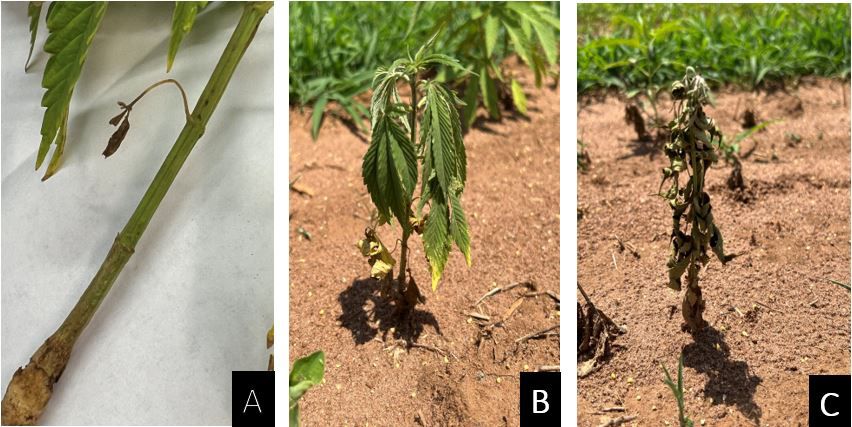This publication highlights the presence, damage, and management of imported fire ants in industrial hemp production. This UF/IFAS Extension publication offers practical knowledge to researchers, Extension agents, growers, crop consultants, agricultural professionals, and students on the effects and management of imported fire ants in industrial hemp production. The 2014 and 2018 Farm Bills have renewed interest in industrial hemp production in the United States. Imported fire ants have limited the yields, making them one of the dominant pests of industrial hemp. However, information on the nature of the damage and the management of fire ants is limited, especially in Florida.
Introduction
Fire ants (Hymenoptera: Formicidae) are a predominant insect pest in gardens, crop fields, and households today (Drees et al. 2008; Depenbrock 2021). Fire ants were accidentally brought to the US from South America (Collins and Scheffrahn 2020). The two major invasive species in the US are the red imported fire ant (Solenopsis invicta Buren; Figure 1) and the black imported fire ant (Solenopsis richteri Forel; Figure 2). Callcott and Collins (1996) reported that fire ants were first identified in the US in Mobile, Alabama, in 1918 (black imported fire ants) and the late 1930s (red imported fire ants). Since then, imported fire ants have distributed widely across the US, including (but not necessarily limited to) Arkansas, California, Florida, Georgia, Kentucky, Louisiana, Mississippi, New Mexico, North and South Carolina, Oklahoma, Tennessee, Texas, and Virginia (Collins and Scheffrahn 2020).
Imported fire ants were first reported in Florida in 1939, with red imported fire ants more widely distributed than black imported fire ants (Callcott and Collins 1996). Fire ants commonly nest in earthen mounds that may be up to 12 inches high and approximately 8–10 inches wide. Large, mature colonies can each contain over 230,000 ants. The queen can live for more than seven years. Fire ants may be more active on sunny days with temperatures ranging from 65°F to 95°F. In Florida, their activity may be more pronounced during the onset of warm summer temperatures.
Red fire ants can be especially harmful when they establish mounds at or near the base of the hemp plant (Figure 2). This publication highlights ways to identify fire ants in hemp fields, their damage, and potential management techniques.

Credit: Center of Invasive Species Research (2023)
Hemp Damage by Fire Ants
In industrial hemp production, red fire ants are aggressive pests that damage the roots, seeds, seedlings, stems, and foliage (Figure 2). The ant damage usually results in wilting as well as disruption of the hemp plant metabolic process, which leads to plant death. Fire ants tunnel through the stem of the hemp plant and deform the roots, thereby disrupting the flow and uptake of fluids in the plant (Figure 2) (Hirsch and Kesheimer 2021). If damage is not detected early and colonies are not contained, fire ants will spread quickly to a new location in the hemp field. Collins and Scheffrahn (2020) reported that significant monetary losses arise from crop root system interference by red fire ants.
Management of Fire Ants in Industrial Hemp
Insect pest management in industrial hemp production is still in its infancy, with this information established in response to ongoing research across the United States. Therefore, this publication is intended as guidance without conclusive assurance on the precise method of managing fire ants in industrial hemp. However, several success stories have been recorded in hemp experimental trials in Florida. Observations from the southern United States (Florida, Georgia, Kentucky, Texas, Virginia) on fire ant management indicate that fire ants may be managed but not eradicated from infested fields (Drees et al. 2008). Control is limited by the ability to treat all infested areas in a field.
Most fruit and vegetable farmers as well as hemp growers have attempted to control fire ants by treating individual ant mounds (Drees et al. 2008). This approach is usually not cost-effective because treatment of individual fire ant mounds costs up to $3 per mound. The principle of fire ant control is to eliminate the queen or prevent further reproduction of worker ants. Killing the queen can be very difficult. Queens may preserve the colony by migrating after disturbance to their nest. Control tactics that mainly target the worker ants are usually not effective as a long-term solution because the queen can produce more worker ants within a few weeks (Mull et al. 2020).
Biological, chemical, or cultural control tactics can be implemented for fire ant control in hemp. Growers should adopt integrated cultural and chemical management techniques for optimal results. Biological control measures are not a common practice for fire ant control in north and western Florida because most biocontrol agents available for purchase (such as parasitic nematodes) are ineffective on imported fire ants. However, fire ant biological controls such as the fire ant-decapitating phorid flies and fire ant-specific pathogens are established in Florida (UF/IFAS Extension 2018).
Chemical fire ant control involves using ant baits or contact insecticides with active ingredients capable of dispersing and disrupting the metabolic processes of the fire ants. Insecticide development specifically for hemp production is still ongoing. Additionally, contact insecticides tend to disperse the ant colony to new un-infested areas. Ant control efficacy and residual efficacy vary. Therefore, the use of ant baits is more appropriate for Florida hemp production.
The fire ant baits are generally a granular formulation containing a food lure mixed with active ingredients that can affect the fire ant's nervous system, reproduction, or metabolism. Effective baits can control fire ants for as long as 20 months. Table 1 lists some of the available pesticide active ingredients for fire ant (and other pest) control in hemp in Florida.
Table 1. Active ingredients for fire ant control in hemp as approved for use in Florida by FDACS (2022).
For optimal results, baits must be freshly prepared and applied during conditions of active foraging by the ants (Drees et al. 2008). The efficacy of fire ant baits also declines with moisture contact, sunlight, and extreme heat conditions (Drees et al. 2008). For the best results, broadcast in the evening and avoid wet grounds or rainy days. Furthermore, some fire ant bait products contain one or more active ingredients which affect the digestion, metabolism, growth, and reproduction of fire ants in hemp fields (Drees et al. 2008). However, the use of other FDACS-approved active ingredients listed in Table 1 is also effective for fire ant control in industrial hemp.
Fire ant baits should not be mixed with granular fertilizers because the baits can absorb oils that may make the bait less attractive to the ants. Handheld spreaders can be used on fields at application ranges of 1–5 lb/acre, while push-type spreaders can be potentially utilized for higher-volume bait applications. The use of petrol, chlorine, or ammonia is not recommended for fire ant control in industrial hemp or other crops because they are toxic substances capable of inducing soil and groundwater contamination (Drees et al. 2008).
Summary
- Fire ants are emerging as one of the predominant insect pests in industrial hemp.
- No single method is most effective for fire ant control in industrial hemp fields.
- Approved insecticides for fire ant control in industrial hemp are limited.
- Baits can be utilized as a cheap and simple measure for fire ant control in hemp.
- Bait efficacy depends on heat, moisture, and sunlight conditions.
- Apply bait during the evenings and avoid application on wet grounds for optimal results. Read and follow the directions on the product label.

Credit: Hardeep Singh
References
Callcott, A. M. A., and H. L. Collins. 1996. “Invasion and Range Expansion of Red Imported Fire Ant (Hymenoptera: Formicidae) in North America from 1918–1995.” Florida Entomologist 79 (2): 240–251. https://doi.org/10.2307/3495821
Center of Invasive Species Research. 2023. “Red Imported Fire Ant.” https://cisr.ucr.edu/invasive-species/red-imported-fire-ant
Collins, L., and R. H. Scheffrahn. 2020. “Red Imported Fire Ant Solenopsis invicta Buren (Insecta: Hymenoptera: Formicidae: Myrmicinae).” EENY-195. Gainesville: University of Florida Institute of Food and Agricultural Sciences. https://edis.ifas.ufl.edu/publication/IN352
Deans Services. 2022. “9 Common Fire Ants in Florida.” https://www.deansservices.com/about/our-blog/common-types-ants-florida
Depenbrock, L. M. 2021. “Fire Ant Management in Citrus.” Citrus Industry: 24–25.
Drees, B. M., K. Schofield, E. Brown, P. Nester, M. Keck, and K. Flanders. 2008. “Fire Ant Control: The Two-Step Method and Other Approaches.” Publication L-5496. Texas A&M AgriLife Extension Service.
Florida Department of Agriculture and Consumer Services (FDACS). 2022. “FDACS Guide List – Pesticide Products for Use on Hemp.” https://ccmedia.fdacs.gov/content/download/91490/file/fdacs-guide-list-pesticide-products-for-use-on-hemp-2020.pdf
Global Invasive Species Database. 2019. “Species Profile: Solenopsis invicta.” Accessed on August 3, 2023. http://www.iucngisd.org/gisd/species.php?sc=77
Hirsch, K., and K. Kesheimer. 2021. “Fire Ants in Hemp.” Alabama Cooperative Extension System. https://www.aces.edu/wp-content/uploads/2021/07/ANR2766_FireAntsInHemp_070721L-G.pdf
Mull, M. M., L. R. Spears, and R. Davis. 2020. “Imported Fire Ants [Solenopsis invicta Buren and Solenopsis richteri Forel].” ENT-214-20-PR. Utah State University Extension and Utah Plant Pest Diagnostic Laboratory.
UF/IFAS Extension 2018. “Sustainable Fire Ant Control.” UF/IFAS Extension. https://sfyl.ifas.ufl.edu/lawn-and-garden/sustainable-fire-ant-control/